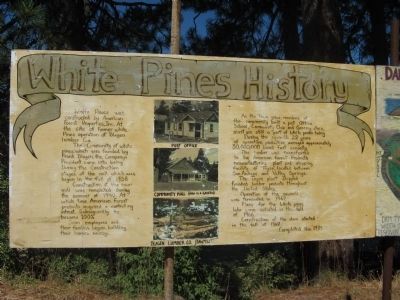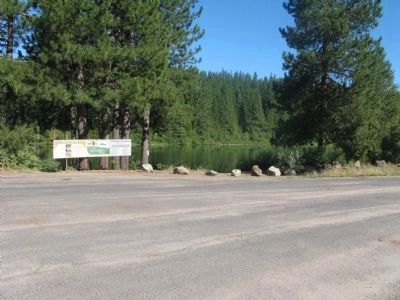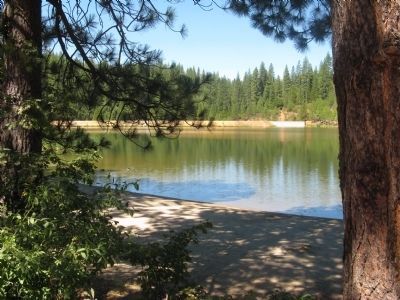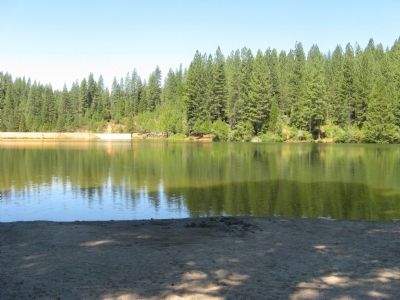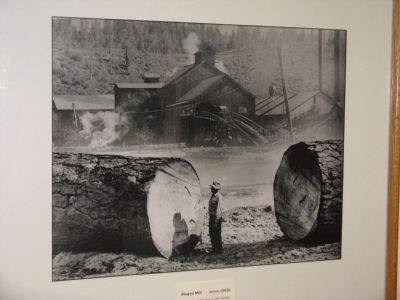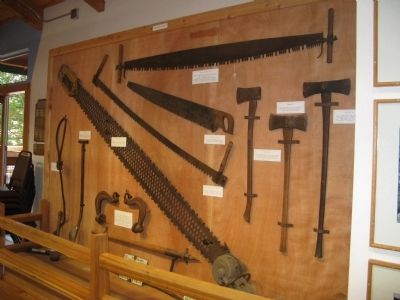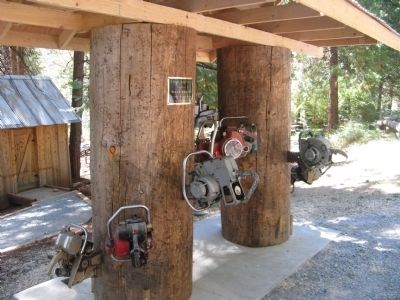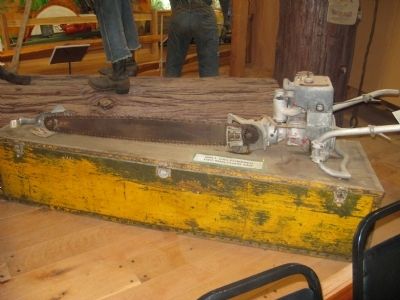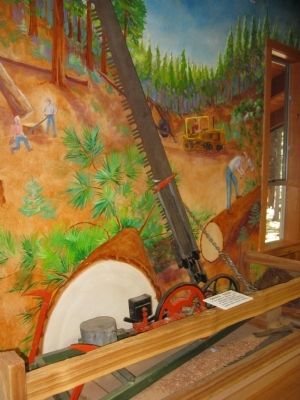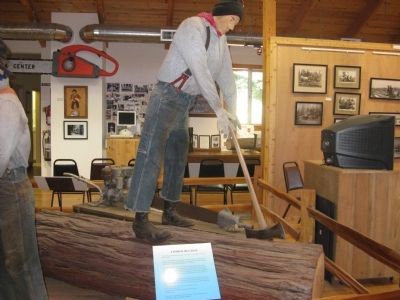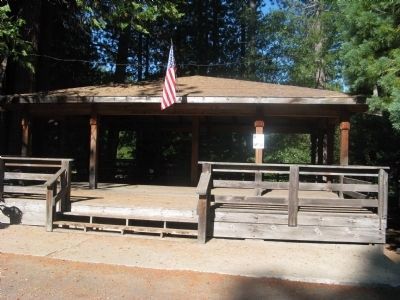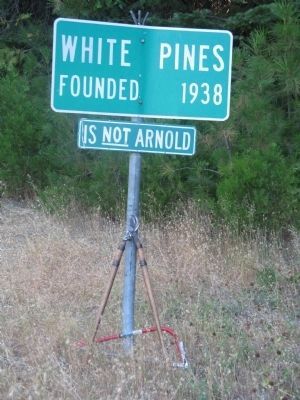White Pines in Calaveras County, California — The American West (Pacific Coastal)
White Pines History
White Pines was constructed by American Forest Properties, Inc. at the site of former White Pines operation of Blagen Lumber Co.
The community of White Pines, which was founded by Frank Blagen, the company president, came into being during the construction stages of the mill which was begun in the fall of 1938.
Construction of the sawmill was completed during the summer of 1940. At which time American Forest Products acquired a controlling interest. Subsequently to become 100%.
Soon employees and their families began building their homes nearby…
As the town grew, members of the community built a Post Office, school, Community Club, and grocery store, most are still a part of White Pines today.
During the sawmill’s 22 years of operation, production averaged approximately 30,000,000 board feet annually.
The lumber was transferred to the American Forest Products manufacturing plant and shipping facility at Toyon, located between San Andreas and Valley Springs.
The Toyon plant shipped finished lumber products throughout the United States.
Operation of the sawmill was terminated in 1962.
Plans for the White Pines Lake were initiated in the Fall of 1966.
Construction of the dam started in the Fall of 1969…
…completed Nov. 1970.
Topics. This historical marker is listed in these topic lists: Horticulture & Forestry • Industry & Commerce. A significant historical year for this entry is 1938.
Location. 38° 16.082′ N, 120° 20.431′ W. Marker is in White Pines, California, in Calaveras County. Marker can be reached from Blagen Road / Forest Route 7N08, 0.9 miles north of Ebbetts Pass Scenic Byway (California Highway 4). Marker is located across the parking lot from the Moose Lodge. Touch for map. Marker is in this post office area: Arnold CA 95223, United States of America. Touch for directions.
Other nearby markers. At least 8 other markers are within 5 miles of this marker, measured as the crow flies. Doc S.C. Linebaugh Park (approx. ¼ mile away); California Big Trees State Park (approx. 1.9 miles away); Discovery and Exploitation (approx. 1.9 miles away); Hanging On By A Branch (approx. 2.2 miles away); Dorrington Hotel (approx. 4.1 miles away); Avery Hotel (approx. 4.6 miles away); a different marker also named The Avery Hotel (approx. 4.6 miles away); Avery One-Room School House (approx. 4.8 miles away).
More about this marker. A representative from the Sierra Nevada Logging Museum reported that there are plans to upgrade and re-do the marker.
Additional commentary.
1. Timber Faller and Limber-Bucker
Timber Faller* - See Photo #12
* Falling and faller are the western version of the old English word for
cutting down a tree: “felling”.
Clothing
Boots were heavy and made of leather. Feet and legs needed to be protected so the logger wouldn’t slip or fall. His boots often had either “lug” soles or nails called chalks (pronounced “corks”.)
Trousers were a type of denim, modified for safety functioning. When purchased they came full length, but full length pants could get caught in machinery or down slash. As the faller worked around machinery or down timber he could have pant legs that caused him to trip. The solution was to “stag” the pants or take a knife and hack them off at a length halfway up the calf.
Suspenders were essential since the faller couldn’t stop to “hike up” his trousers with a chainsaw over his shoulder! Trousers simply could not be allowed to slide downward and interfere with walking or working with equipment.
Lumber-Bucker – See Photo #13
The clothing on the Lumber-Bucker was similar to the faller and for the same reasons.
It was very important for the limber-bucker to wear cork boots, have stagged pants and to wear suspenders. He had
keep from tripping on his pants or slipping off the log he was limbing.
The limber climbed up on the tree just after the faller put it on the ground. He would use a tape or pre-measured stick to measure how far he was moving up the tree as he cut off the limbs. As he reached the end of the desired 16’ or 32’ log length, he would cut a mark in the bark for a cut off point. Logs were at increments of 16 feet with an allowance of 6” for trim.
After completing the limbing job and cutting off the top, the limber could become a “bucker” – the person who cuts the down tree into the desired log lengths.
The bucker had four types of saws from which to choose:
• one-man or two-man cross-cut or “misery whip”.
• the electric chainsaw.
• the gas-powered chain saw set for vertical cut.
• the drag-saw.
Bucking was a dangerous job since logs could spring back, roll downslope, split or drop unexpectedly.
From information posted at the exhibit
— Submitted August 19, 2010.
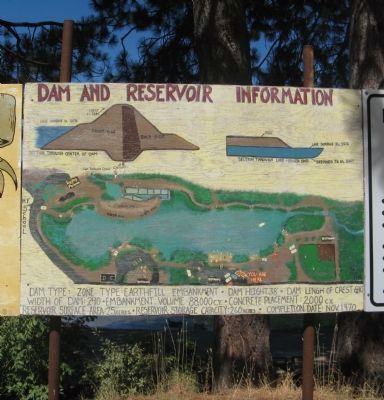
Photographed By Syd Whittle, August 16, 2010
5. Dam and Reservoir Information
Dam Type: Zone type earthfill embankment • Dam height 38' • Dam length of crest 640’ • Width of dam: 240 • Embankment volume 88,000c.y. • Concrete placement: 2000c.y. Reservoir surface area: 25 acres • Reservoir storage capacity: 260 acres • Completion date: Nov. 1970
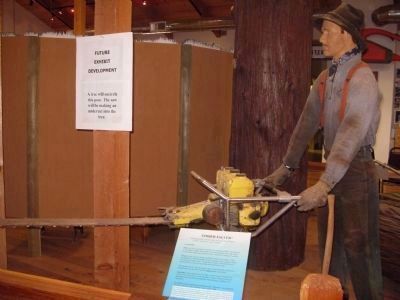
Photographed By Syd Whittle, August 16, 2010
12. Timber Faller
The faller model is using a gasoline-powered chainsaw. Chainsaws were replacing the hand "cross cut" saw or "misery whip" in the 1930's.
This saw is one of the first power saws used in the woods. This saw was so heavy that it had to be rotated 90 degrees. For a verticle cut the blade had to be loosened at the collar and turned to a verticle position. The gasoline-powered chainsaw was an improvement in cutting speed, but it was still hard work.
(From information posted at the exhibit)
This saw is one of the first power saws used in the woods. This saw was so heavy that it had to be rotated 90 degrees. For a verticle cut the blade had to be loosened at the collar and turned to a verticle position. The gasoline-powered chainsaw was an improvement in cutting speed, but it was still hard work.
(From information posted at the exhibit)
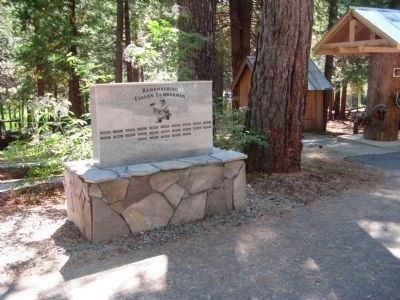
Photographed By Syd Whittle, August 16, 2010
14. Fallen Lumbermen Memorial
Located at the Sierra Nevada Logging Museum
Remembering Fallen Lumbermen
Roger Flanders • Red Grunder • Herb Parks • Donald Kinkey • Grandville Townsend • Bob Guggenmos • Roy Ballard • Albert Snyder Green • Harold Richard Ryan • Earl Dalton • Dick Laymon • Allen Ball • Glen Linebaugh • Ray Rollingworth • Tony Lopez • Ralph Modrell • Ernest Koch • Gabriel Rice • Rodney Modrell • William Fairchilds • Jens Jensen • Bobby Tingel • Forrest Swimmey
Credits. This page was last revised on December 29, 2022. It was originally submitted on August 18, 2010, by Syd Whittle of Mesa, Arizona. This page has been viewed 2,672 times since then and 44 times this year. Photos: 1. submitted on August 18, 2010, by Syd Whittle of Mesa, Arizona. 2. submitted on August 23, 2010, by Syd Whittle of Mesa, Arizona. 3, 4, 5, 6, 7. submitted on August 18, 2010, by Syd Whittle of Mesa, Arizona. 8, 9, 10, 11, 12, 13, 14. submitted on August 19, 2010, by Syd Whittle of Mesa, Arizona. 15, 16. submitted on August 23, 2010, by Syd Whittle of Mesa, Arizona.
